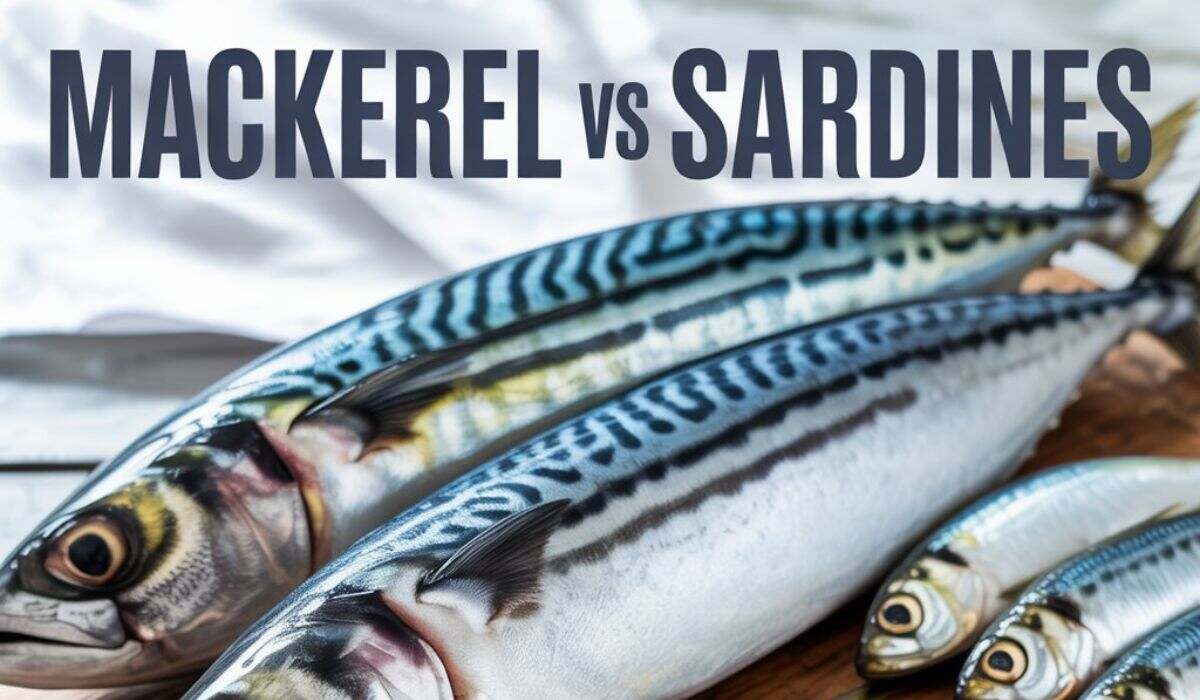Mackerel vs Sardinesa debate that often sparks curiosity among seafood lovers. Both fish are nutrient-rich, affordable, and versatile, yet each offers unique benefits. Mackerel is prized for its bold flavor and high omega-3 fatty acids, while sardines shine with their calcium, protein, and low mercury levels.
Understanding their differences helps you choose the right fish for your diet, taste, and health goals. In this guide, we’ll explore their nutrition, flavor, sustainability, and even expert opinionshelping you decide which one truly deserves a place on your plate. Let’s dive deeper into this delicious and healthy comparison.
What Are Mackerel and Sardines?
Mackerel and sardines both belong to the pelagic fish family, thriving in open waters across the world. Mackerel, known for its shimmering blue-green skin, is commonly found in the Atlantic and Pacific Oceans. It has a rich, oily texture that makes it a favorite in grilled and smoked dishes. Sardines, however, are smaller, silver-scaled fish that travel in large schools and are often canned in oil, tomato sauce, or brine.
Despite their size, sardines are packed with nutrientsespecially vitamin D, calcium, and omega-3s. These differences in habitat and diet contribute to the distinct taste and nutritional profile of each fish.
Nutritional Comparison: Mackerel vs Sardines
When comparing Mackerel vs Sardines nutrition, both are exceptional sources of protein and omega-3 fatty acids, yet they differ in certain key areas. Mackerel contains slightly more fat and caloriesideal for those following high-protein or keto diets. Sardines, meanwhile, offer higher calcium levels since they’re consumed with bones. Both fish provide vitamin B12, selenium, and phosphorus, vital for heart and brain health.
| Nutrient (100g) | Mackerel | Sardines |
| Calories | 305 kcal | 208 kcal |
| Protein | 19 g | 25 g |
| Fat | 25 g | 11 g |
| Omega-3 | 3.0 g | 1.5 g |
| Calcium | 12 mg | 382 mg |
| Vitamin D | 360 IU | 272 IU |
| Mercury Level | Medium | Low |
Both fish support cardiovascular function, reduce inflammation, and promote healthy skin.
Taste and Texture: Which One Wins?
The taste difference between mackerel and sardines is quite noticeable. Mackerel has a deep, rich, and buttery flavor, often described as meaty and satisfyingperfect for grilling, smoking, or Japanese dishes like Saba Shioyaki. Sardines, in contrast, are milder with a salty and slightly briny taste, making them excellent in salads, sandwiches, or Mediterranean recipes.
A food blogger once wrote:
“If sardines are light jazz, mackerel is a full orchestrabold, layered, and unforgettable.”
For beginners, sardines are easier to enjoy due to their mildness, while mackerel attracts those who love a robust seafood flavor.
Health Benefits of Mackerel and Sardines
Both mackerel and sardines deliver impressive health benefits that support body and mind. Mackerel is rich in omega-3 fatty acids (EPA and DHA), which reduce triglycerides and boost brain performance. It also offers selenium and vitamin B12, essential for energy metabolism. Sardines, however, provide high levels of calcium, vitamin D, and coenzyme Q10, which strengthen bones and support heart health.
Scientific studies show that regular consumption of sardines or mackereljust two servings per weekcan lower the risk of cardiovascular disease by up to 36%. Both fish also promote healthy aging, better skin texture, and reduced inflammation, making them true superfoods for any diet.
Mackerel vs Sardines for Weight Loss
If you’re aiming for a lean body, sardines are your go-to option. Containing just 208 kcal per 100g, they are low in fat but high in protein, which helps you feel full for longer. Mackerel, while more calorie-dense, provides healthy fats that fuel energy and aid metabolismideal for those on keto or low-carb diets.
For weight watchers, sardines fit better into low-calorie meal plans, while mackerel works well for athletes and those needing sustained energy. The balance of protein and omega-3 in both fish makes them excellent choices for healthy, sustainable weight management.
Environmental and Sustainability Factors
In today’s eco-conscious world, sustainability matters as much as nutrition. Sardines are considered one of the most sustainable seafood options, reproducing quickly and leaving minimal impact on ocean ecosystems. Mackerel also fares well environmentally, though certain species face regional overfishing.
Look for MSC-certified sardines and wild-caught Atlantic mackerel to ensure you’re making environmentally friendly choices. Both species rank high on eco-lists, supporting marine biodiversity and sustainable food systems. Choosing these fish is not only good for youit’s good for the planet.
Price and Market Availability
Price often influences consumer choice in the mackerel vs sardines debate. Sardines are generally cheaper, costing around $1–$2 per can, while fresh mackerel can range from $5–$8 per pound depending on the region. Sardines are available worldwide in canned form, while mackerel is often sold fresh or frozen in coastal areas.
Both are budget-friendly seafood options, offering excellent value for money considering their rich nutritional benefits. For families, students, or health enthusiasts on a budget, sardines make daily seafood consumption affordable without compromising quality.
Cooking and Culinary Uses
Both fish are versatile and suit different cuisines. Mackerel is fantastic when grilled, baked, or smoked, bringing out its deep flavor. It’s widely used in Japanese, Korean, and European dishes. Sardines, on the other hand, fit perfectly in Mediterranean dietstossed into salads, pasta, or eaten straight from the can with lemon.
Case Study: A 2024 Mediterranean study found participants who consumed sardines thrice weekly improved omega-3 levels by 15% in 8 weeks. This shows the real-world impact of adding these nutrient-dense fish to regular meals.
Side-by-Side Comparison Table
| Feature | Mackerel | Sardines |
| Calories | 305 | 208 |
| Protein | 19g | 25g |
| Fat | 25g | 11g |
| Omega-3 | 3.0g | 1.5g |
| Vitamin D | 360 IU | 272 IU |
| Calcium | 12 mg | 382 mg |
| Mercury | Medium | Low |
| Sustainability | Good | Excellent |
Both fish are nutrient-packed, sustainable, and heart-healthy, making them excellent dietary staples.
Which Is Better for Your Diet?
Your choice between mackerel and sardines depends on personal goals. If you’re seeking more healthy fats, omega-3s, and flavor, mackerel is ideal. For low-calorie, high-calcium diets, sardines are unbeatable. Both support heart health, brain function, and overall well-being.
For keto or paleo diets → choose mackerel.
For Mediterranean or calorie-conscious diets → choose sardines.
In short, it’s not about which is “better”it’s about which suits your lifestyle and nutrition needs best.
Common Myths About Mackerel and Sardines
There are several misconceptions about these fish that deserve clarification:
- Myth: “Canned fish is unhealthy.”
Truth: Canned sardines retain their nutrients and are safe when packed in BPA-free containers. - Myth: “Mackerel is too oily.”
Truth: Its natural oils are omega-3 rich and great for skin and heart health. - Myth: “Sardines are for older people.”
Truth: They’re perfect for everyoneespecially for bone health and muscle growth.
Expert Opinions and Final Verdict
Nutritionists agree that both mackerel and sardines are nutritional powerhouses. The American Heart Association recommends consuming fatty fish like these at least twice a week to reduce heart disease risk. Mackerel provides more energy and taste, while sardines offer calcium, lean protein, and lower mercury levels.
FAQs About Mackerel vs Sardines
Which is healthier mackerel or sardines?
Both mackerel and sardines are highly nutritious, but sardines have a slight edge due to their lower mercury levels and higher calcium content. Mackerel provides more omega-3 fatty acids and vitamin D, making it excellent for brain and heart health. If you’re seeking a safer option for frequent consumption, sardines are generally preferred.
Do mackerel and sardines taste the same?
Not exactly. Mackerel has a stronger, richer, and oilier flavor, while sardines taste milder and slightly salty. People who prefer a bold, meaty flavor often go for mackerel, whereas sardines appeal to those who enjoy a light, savory fish taste.
Which fish has more protein mackerel or sardines?
Mackerel typically contains around 19–20 grams of protein per 100 grams, while sardines offer about 21–23 grams per 100 grams. The difference is small, but sardines slightly win in protein content, making them great for muscle recovery and growth.
Is mackerel higher in mercury than sardines?
Yes. Mackerel, especially larger varieties like king mackerel, can contain higher mercury levels, which limits how often it should be eaten. Sardines, being small and lower on the food chain, have very low mercury, making them safer for regular consumption even for children and pregnant women.
Can I use sardines and mackerel interchangeably in recipes?
In some dishes, yes especially in salads, sandwiches, or pasta. However, due to mackerel’s stronger flavor and texture, it may overpower lighter recipes where sardines work better. For grilling or smoking, mackerel is ideal, but for snacks or spreads, sardines are the better choice.
Which fish is better for weight loss sardines or mackerel?
If you’re counting calories, sardines are better for weight management. They contain fewer calories and fat per serving while still being rich in protein and nutrients. Mackerel, though more calorie-dense, is excellent for keto or high-fat diets due to its omega-3 and healthy fat profile.
Are canned mackerel and sardines as healthy as fresh ones?
Yes when packed in water or olive oil, both canned mackerel and sardines retain most of their nutrients, including omega-3s, protein, and calcium. Avoid versions packed in heavy sauces or excessive salt for the healthiest choice.








